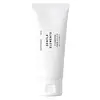What's inside
What's inside
 Key Ingredients
Key Ingredients

 Benefits
Benefits

 Concerns
Concerns

 Ingredients Side-by-side
Ingredients Side-by-side

Water
Skin ConditioningGlycerin
HumectantSodium Cocoyl Isethionate
CleansingCoco-Betaine
CleansingStearyl Alcohol
EmollientGlyceryl Stearate
EmollientSodium Methyl Cocoyl Taurate
CleansingSodium Chloride
MaskingMoringa Oleifera Seed Oil
EmollientAscorbyl Glucoside
AntioxidantAscorbic Acid
AntioxidantTremella Fuciformis Extract
HumectantOryza Sativa Extract
AbsorbentSaccharide Isomerate
HumectantSodium Hyaluronate
HumectantHyaluronic Acid
HumectantAdenosine
Skin ConditioningCurcuma Longa Root Extract
MaskingQuillaja Saponaria Bark Extract
CleansingMelia Azadirachta Flower Extract
Skin ConditioningMelia Azadirachta Leaf Extract
Skin ConditioningOcimum Sanctum Leaf Extract
Skin ConditioningCorallina Officinalis Extract
Skin ConditioningNiacinamide
SmoothingBetaine
HumectantTrehalose
HumectantMannitol
HumectantCitric Acid
BufferingKaolin
AbrasiveCoco-Glucoside
CleansingMicrocrystalline Cellulose
AbsorbentCeramide NP
Skin ConditioningHydrogenated Lecithin
EmulsifyingGlycine
BufferingSerine
MaskingGlutamic Acid
HumectantPhytosphingosine
Skin ConditioningAspartic Acid
MaskingLeucine
Skin ConditioningAlanine
MaskingLysine
Skin ConditioningArginine
MaskingTyrosine
MaskingPhenylalanine
MaskingProline
Skin ConditioningThreonine
Valine
MaskingIsoleucine
Skin ConditioningHistidine
HumectantCysteine
AntioxidantMethionine
Skin ConditioningDiamond Powder
Abrasive1,2-Hexanediol
Skin ConditioningSodium Phytate
Sodium Citrate
BufferingZea Mays Starch
AbsorbentHydroxypropyl Starch Phosphate
Butylene Glycol
HumectantCaprylyl Glycol
EmollientCitrus Aurantium Bergamia Fruit Oil
MaskingRosmarinus Officinalis Leaf Oil
MaskingPinus Sylvestris Leaf Oil
MaskingLavandula Angustifolia Oil
MaskingWater, Glycerin, Sodium Cocoyl Isethionate, Coco-Betaine, Stearyl Alcohol, Glyceryl Stearate, Sodium Methyl Cocoyl Taurate, Sodium Chloride, Moringa Oleifera Seed Oil, Ascorbyl Glucoside, Ascorbic Acid, Tremella Fuciformis Extract, Oryza Sativa Extract, Saccharide Isomerate, Sodium Hyaluronate, Hyaluronic Acid, Adenosine, Curcuma Longa Root Extract, Quillaja Saponaria Bark Extract, Melia Azadirachta Flower Extract, Melia Azadirachta Leaf Extract, Ocimum Sanctum Leaf Extract, Corallina Officinalis Extract, Niacinamide, Betaine, Trehalose, Mannitol, Citric Acid, Kaolin, Coco-Glucoside, Microcrystalline Cellulose, Ceramide NP, Hydrogenated Lecithin, Glycine, Serine, Glutamic Acid, Phytosphingosine, Aspartic Acid, Leucine, Alanine, Lysine, Arginine, Tyrosine, Phenylalanine, Proline, Threonine, Valine, Isoleucine, Histidine, Cysteine, Methionine, Diamond Powder, 1,2-Hexanediol, Sodium Phytate, Sodium Citrate, Zea Mays Starch, Hydroxypropyl Starch Phosphate, Butylene Glycol, Caprylyl Glycol, Citrus Aurantium Bergamia Fruit Oil, Rosmarinus Officinalis Leaf Oil, Pinus Sylvestris Leaf Oil, Lavandula Angustifolia Oil
Salicylic Acid
MaskingMelaleuca Alternifolia Leaf Extract
PerfumingCamellia Sinensis Leaf Extract
AntimicrobialWater
Skin ConditioningMyristic Acid
CleansingGlycerin
HumectantPotassium Hydroxide
BufferingPropylene Glycol
HumectantStearic Acid
CleansingLauric Acid
CleansingPEG-75
HumectantGlyceryl Stearate
EmollientPEG-100 Stearate
Salvia Officinalis Leaf Extract
CleansingOriganum Majorana Leaf Extract
AntiseborrhoeicOcimum Basilicum Leaf
TonicLepidium Meyenii Root Extract
Skin ConditioningBambusa Vulgaris Water
Skin ConditioningMelaleuca Alternifolia Leaf Oil
AntioxidantPoloxamer 184
EmulsifyingDisodium EDTA
Maltodextrin
AbsorbentParfum
MaskingPhenoxyethanol
PreservativeHexyl Cinnamal
PerfumingLimonene
PerfumingLinalool
PerfumingBenzyl Benzoate
AntimicrobialSalicylic Acid, Melaleuca Alternifolia Leaf Extract, Camellia Sinensis Leaf Extract, Water, Myristic Acid, Glycerin, Potassium Hydroxide, Propylene Glycol, Stearic Acid, Lauric Acid, PEG-75, Glyceryl Stearate, PEG-100 Stearate, Salvia Officinalis Leaf Extract, Origanum Majorana Leaf Extract, Ocimum Basilicum Leaf, Lepidium Meyenii Root Extract, Bambusa Vulgaris Water, Melaleuca Alternifolia Leaf Oil, Poloxamer 184, Disodium EDTA, Maltodextrin, Parfum, Phenoxyethanol, Hexyl Cinnamal, Limonene, Linalool, Benzyl Benzoate
Ingredients Explained
These ingredients are found in both products.
Ingredients higher up in an ingredient list are typically present in a larger amount.
Glycerin is already naturally found in your skin. It helps moisturize and protect your skin.
A study from 2016 found glycerin to be more effective as a humectant than AHAs and hyaluronic acid.
As a humectant, it helps the skin stay hydrated by pulling moisture to your skin. The low molecular weight of glycerin allows it to pull moisture into the deeper layers of your skin.
Hydrated skin improves your skin barrier; Your skin barrier helps protect against irritants and bacteria.
Glycerin has also been found to have antimicrobial and antiviral properties. Due to these properties, glycerin is often used in wound and burn treatments.
In cosmetics, glycerin is usually derived from plants such as soybean or palm. However, it can also be sourced from animals, such as tallow or animal fat.
This ingredient is organic, colorless, odorless, and non-toxic.
Glycerin is the name for this ingredient in American English. British English uses Glycerol/Glycerine.
Learn more about GlycerinGlyceryl Stearate is a mix of glycerin and stearic acid.
It is used to stabilize the mixing of water and oil ingredients. By preventing these ingredients from separating, it can help elongate shelf life. It can also help thicken the product's texture.
As an emollient, it helps soften skin and supports barrier-replenishing ingredients.
In cosmetics, Glyceryl Stearate is often made from vegetable oils or synthetically produced.
This ingredient may not be fungal-acne safe
Fun fact: The human body also creates Glyceryl Stearate naturally.
Learn more about Glyceryl StearateWater. It's the most common cosmetic ingredient of all. You'll usually see it at the top of ingredient lists, meaning that it makes up the largest part of the product.
So why is it so popular? Water most often acts as a solvent - this means that it helps dissolve other ingredients into the formulation.
You'll also recognize water as that liquid we all need to stay alive. If you see this, drink a glass of water. Stay hydrated!
Learn more about Water